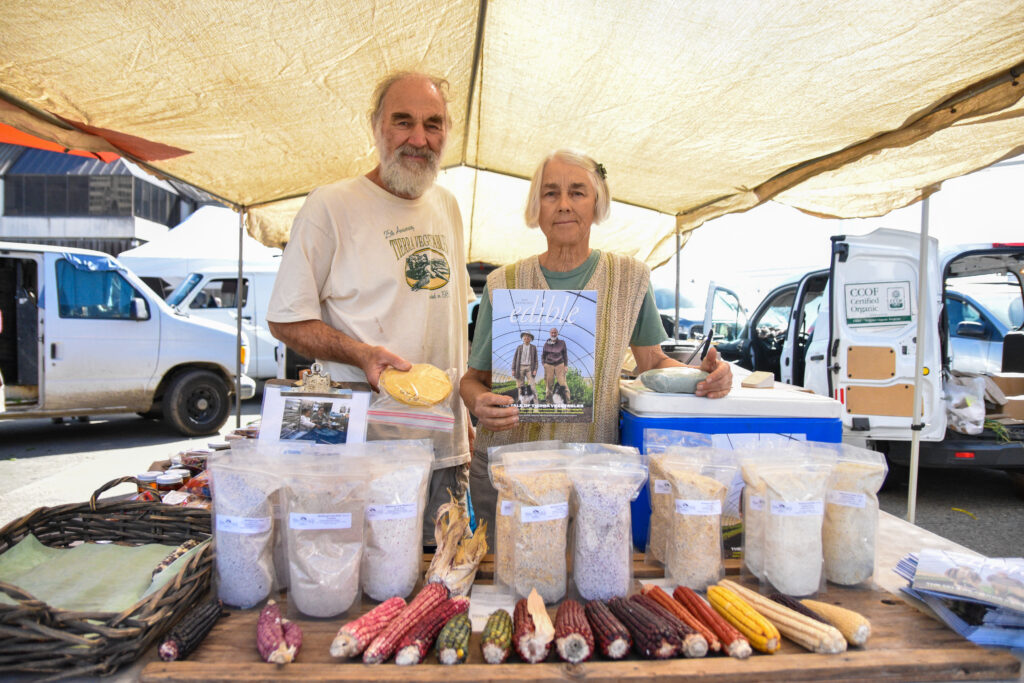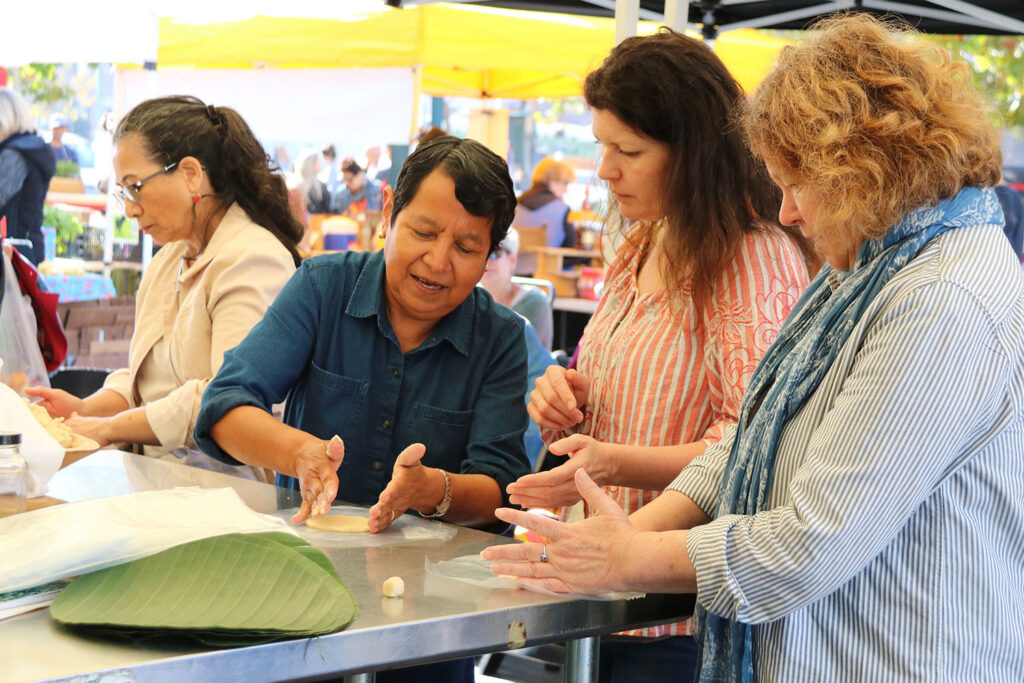Tierra Vegetables Heirloom Corn Brings Full Flavor to Traditional Tortilla Making
Selina Knowles, Communications Coordinator
June 28, 2024

At the Ferry Plaza Farmers Market, home and restaurant chefs alike flock to Tierra Vegetables’ stand, adorned with decorative dried chiles and a rainbow of dried corn ears, for their unique corn meals, corn flours, hominy, handmade tortillas, and more. Almost 45 years after siblings Lee and Wayne started Tierra Vegetables in 1980, they grow a dozen varieties of corn, including many types of Mexican heirloom maize, and they also operate a commercial kitchen where their team makes products with their harvests.
We spoke with Lee to break down the vast diversity of corn beyond the fresh-on-the-cob varieties, the difference between store-bought and freshly made tortillas, and why you should start making your own.

Distinguishing Between Different Types of Corn
“People don’t understand growing corn as a grain because all they know about is sweet corn,” says Lee. In the early days of Tierra Vegetables, Lee and Wayne grew mostly sweet corn, which peaks during the summer months. While fresh, ready-to-eat corn is one of the popular crops of the summer farmers market, it’s not the only kind of corn that thrives in the long, warm days of summer. There are five common types of corn:
- Sweet corn varieties are typically picked early, when the kernels are in their “milk” phase and have not ripened or dried. These varieties originated from genetic mutations of flint and flour corns that prevented the conversion of sugars to starch.
- Flour corn is composed mostly of starch and can be ground into a fine cornmeal. This corn can be eaten in its “milk” stage, when the corn still retains moisture, but it is most commonly harvested when it’s mature and fully dried. It can be used to make breads, tamales, tortillas, pinole, and corn nuts.
- Dent corn is named for the dent that forms at the top of a corn kernel as it dries. The dent is formed because of the presence of harder starches near the kernel’s edges and softer starch in the middle. Dent corn constitutes the majority of commercially raised corn in the world. Its common uses include livestock feed, high-fructose corn syrup, plastics, ethanol, cornmeal, and hominy.
- Flint corn is named for its hard outer layer which protects the soft endosperm inside. The ears are long and slender and grow on tall stalks. Flint corn is often used for masa, hominy, cornmeal, corn nuts, popcorn, and as dried decorative ears.
- When heated, the moisture within popping corn kernels steams until it explodes the kernel and creates the fluffy form we know as popcorn.
As more farmers markets started to be open year-round, the Jameses wanted to diversify their corn to include varieties that could be stored in their mature, dried form and made into value-added products. Compared to the familiar sweet corn, Lee says that the dozen varieties of heirloom flour, dent, flint, and popping corn varieties that Tierra Vegetables grows are “entirely different” in terms of purpose, flavor, and nutritional value.

Preserving and Processing Heirloom Corn Varieties
Currently, Tierra Vegetables grows several Mexican heirloom corn varieties, often introduced to the farmers by friends and farm workers. Known traditionally as maize, corn was domesticated by Olmec and Mayan peoples in the region now known as Mexico some 10,000 years ago, and it is said to be one of the most ancient of the domesticated crops. About 60,000 tons of heirloom corn are produced annually in Mexico today, a kernel in a field of the 23 million tons of white corn grown simultaneously.
There’s a reason why Bay Area chefs, like those at Californios, Octavia, The Progress, and Che Fico, are loyal to Tierra Vegetables’ stand at the Ferry Plaza Farmers Market. Heirloom corn varieties often have more flavor, vitamins, and nutritional value than hybridized corn. At Tierra Vegetables, Wayne confirms that they’re growing a rainbow of unique varieties this year, including Bloody Butcher, Floraini, Hopi Pink, Hickory King Yellow and White, and Ruby Red.
When they first started growing their grain varieties, Lee brought matured (dried) ears to the farmers market, suggesting that shoppers use their blenders to turn the kernels into cornmeal. “We had many people bust their blenders, grinding corn, breaking the glass and wearing out their motors,” says Lee. “So, we bought a mill.”
First, they bought a steel-burr mill to make cornmeal, then a masa molina to make masa and expand their offerings. In Tierra’s commercial kitchen, Lee works with Norma Muños and Queta Reyes, who have been employees of the farm for 10 years and 35 years, respectively. They make cornmeal, masa, and handmade tortillas, in addition to their non-corn value-added food products.

From Kernel to Tortilla
From growing grain corn to hand pressing masa balls into tortillas, Tierra’s products take plenty of patience and attention to detail to produce. Lee describes the process from seed to finished product.
Once the plant is in the ground, Lee lets the corn mature before harvesting it and taking the kernels off of the cob. “You eat sweet corn when it’s totally immature. Whereas with grain corn, it has to mature and dry on the plant before it’s even harvested. So, it takes 3 to 5 times as long to get a mature crop,” says Lee.
Next, she begins the process known as nixtamalization, a traditional maize preparation process that has been used by people in Mexico and across Central America for centuries. This process can vary, but at Tierra Vegetables, first, the kernels are washed and added to a limestone solution. The kernels are then cooked in the solution for about an hour, before being left to soak for up to 24 hours. Then, the kernels are rinsed to remove some of the lime as well as the cellulose seed coat. Lee says that this step makes the corn more easily digestible.
At this step, Lee notes that some industrially produced tortillas and hominy are made with lye rather than limestone. This method adds more sodium hydroxide (“like liquid Drano,” says Lee), compared to the calcium added by the more traditional limestone solution. While using lye is a faster process, Lee says that the final product has a higher sodium content and a chemical aftertaste.
After nixtamalization, the corn gets run through a masa molino (grinder mill). Water is added at this step to make masa or corn flour dough. “It’s an art and a skill to grind it correctly,” says Lee. “You have to add a little bit of water, not too much, not too little, and you have to really know the feel of it to get the correct masa grind.”
Finally, the masa can be rolled into little balls and flattened, either by hand or with a tortilla press, to make a tortilla. “It takes a year to make a tortilla,” says Lee, quoting a regular farmers market shopper, John Casazza, whose wife, Lolita, will be leading a Tortilla Making 101 demo on June 29 at the Foodwise Classroom with Lee.
The process may be long and complex, but the payoff is well worth it. Compared to store-bought tortillas, which often contain plenty of preservatives, Tierra Vegetables’ tortillas are always fresh and packed with the high nutritional value of the farm’s heirloom corn. Or you can buy their cornmeal or fresh masa to make your own tortillas from scratch. “There are a lot of really good heirloom things that need to be maintained,” says Lee.
Support Tierra Vegetables at the Ferry Plaza Farmers Market on Saturday.
Stop by the Foodwise Classroom on Saturday, June 29, for Tortilla Making 101 with Lolita Casazza and Tierra Vegetables.
